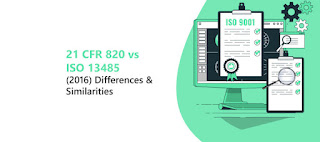"Demystifying Regulatory Requirements: 21 CFR 820 vs. ISO 13485"
21 CFR 820 and ISO 13485 are two distinct sets of Quality Management System (QMS) standards that are relevant to the medical device industry. While they share some similarities, there are also notable differences between them. Here's a comparison:
21 CFR 820 (FDA Quality System Regulation):
2. Legal Requirement: Compliance with 21 CFR 820 is a legal requirement for companies manufacturing medical devices in the United States. Non-compliance can result in regulatory actions and even product recalls.
3. Scope:21 CFR 820 covers a wide range of requirements for the design, manufacturing, labelling, packaging, distribution, and post-market surveillance of medical devices. It also includes requirements for recordkeeping and complaint handling.
4. Risk Management: While 21 CFR 820 does emphasize risk management in various sections, it doesn't have a dedicated section on risk management as ISO 13485 does.
5. Validation: 21 CFR 820 includes requirements for process validation, particularly for manufacturing processes, but it doesn't have detailed guidance on software validation (which is covered separately in FDA guidance documents).
ISO 13485 (Medical Devices - Quality Management Systems):
1. Applicability: ISO 13485 is an international standard applicable to medical device manufacturers worldwide. It is widely adopted by companies seeking to meet global regulatory requirements.
2. Voluntary Standard: ISO 13485 is a voluntary standard, meaning compliance is not a legal requirement. However, it is commonly used as a basis for regulatory compliance in various countries.
3. Scope: ISO 13485 focuses on the quality management system of medical device manufacturers. It covers areas such as risk management, design and development, production, customer satisfaction, and post-market surveillance.
4. Risk Management: ISO 13485 places a strong emphasis on risk management throughout the standard. It includes specific requirements for risk management processes in the design and manufacturing of medical devices.
5. Validation: ISO 13485 includes requirements for validation of processes, including software validation. It provides more detailed guidance on software validation compared to 21 CFR 820.
In summary, 21 CFR 820 is a regulatory requirement specific
to the United States, enforced by the FDA, and mandatory for companies selling
medical devices in the U.S. ISO 13485, on the other hand, is an internationally
recognized standard that is voluntarily adopted by medical device manufacturers
worldwide to demonstrate their commitment to quality and compliance. Companies
often use ISO 13485 as a foundation for meeting regulatory requirements in
various countries, including the EU's Medical Device Regulation (MDR). While
there are similarities between the two standards, ISO 13485 places a stronger
emphasis on risk management and provides more comprehensive guidance on certain
aspects, such as software validation.
Citations:
ISO
13485:2016 | Facts to Know About Quality Management System (complianceg.com)



Comments
Post a Comment